Hazewinkel, Jan Abraham.
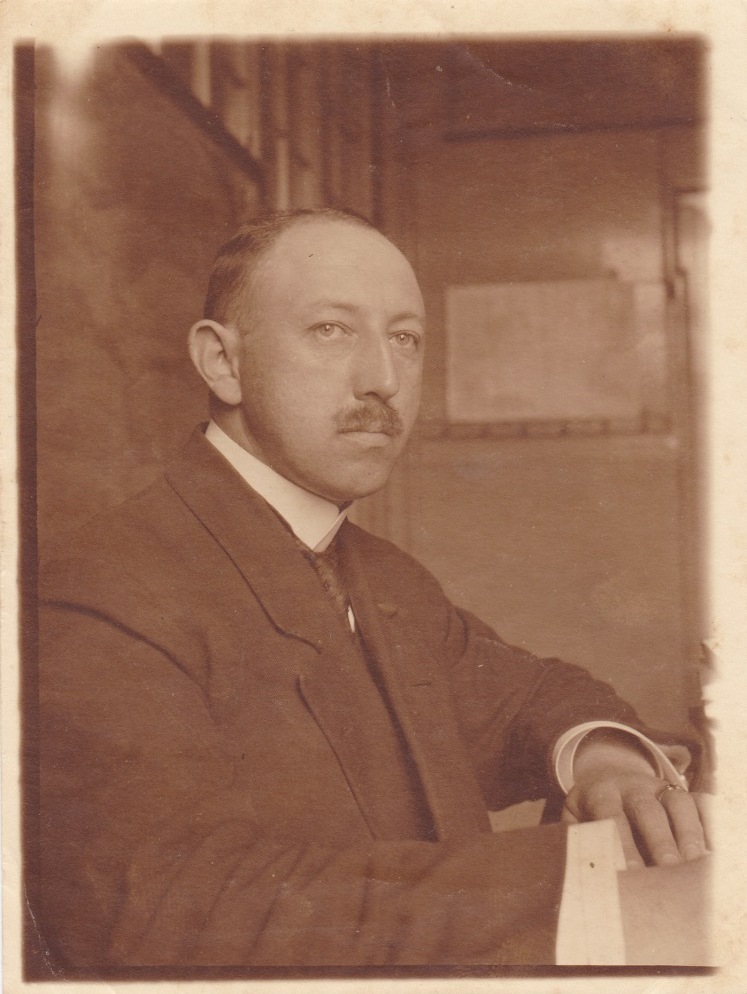
Captain Jan Abraham Hazewinkel. This photo was taken shortly after he became a teacher in 1917 (a)
Jan Abraham Hazewinkel came from a long line of seafarers so much that eventually a complete book was published about all the Captains from this family. Hence it was possible to find quite a bit of information about him. Supplemented by additional information and photos supplied from family. (a)
Jan Abraham was on born on 31 August 1885 in Amsterdam as son of Simon Jan Hazewinkel (Born 25 June 1853 in Veendam – Died 03 May 1942 Bussum) and Armanda Haak (1865 – 1948). Father was listed as a deep sea captain (b, c). He sailed for the KNSM of Amsterdam in the period between 1889 – 1902 (KNSM = is called “Royal Boat” in the English Maritime language). It is with certainty that the first sailing Hazewinkel was a Jan Jans who is noted as such in 1632; although there might have been more before. His son Cornelis Jans was noted as a peat Skipper transporting peat along the inland river ways. And from there is goes forward to the 1900’s. When counting all the deep sea captains our captain was generation 8 and as far as is known the last one who went deep sea and held command. Although the Hazewinkel family originally came from the area of Veendam in the North East of Groningen, the fact that a lot of them were seafarers resulted in the fact that the various factions had moved far away from their town of origin. Hence he lived with his parents in Amsterdam (b) with 3 brothers and 2 sisters. They lived at the Kattenburger plein in Amsterdam which in those days was a predominantly sea faring area, being very close to the harbor. The Maritime Academy was almost at the opposite side, just over the bridge of the nearest canal.
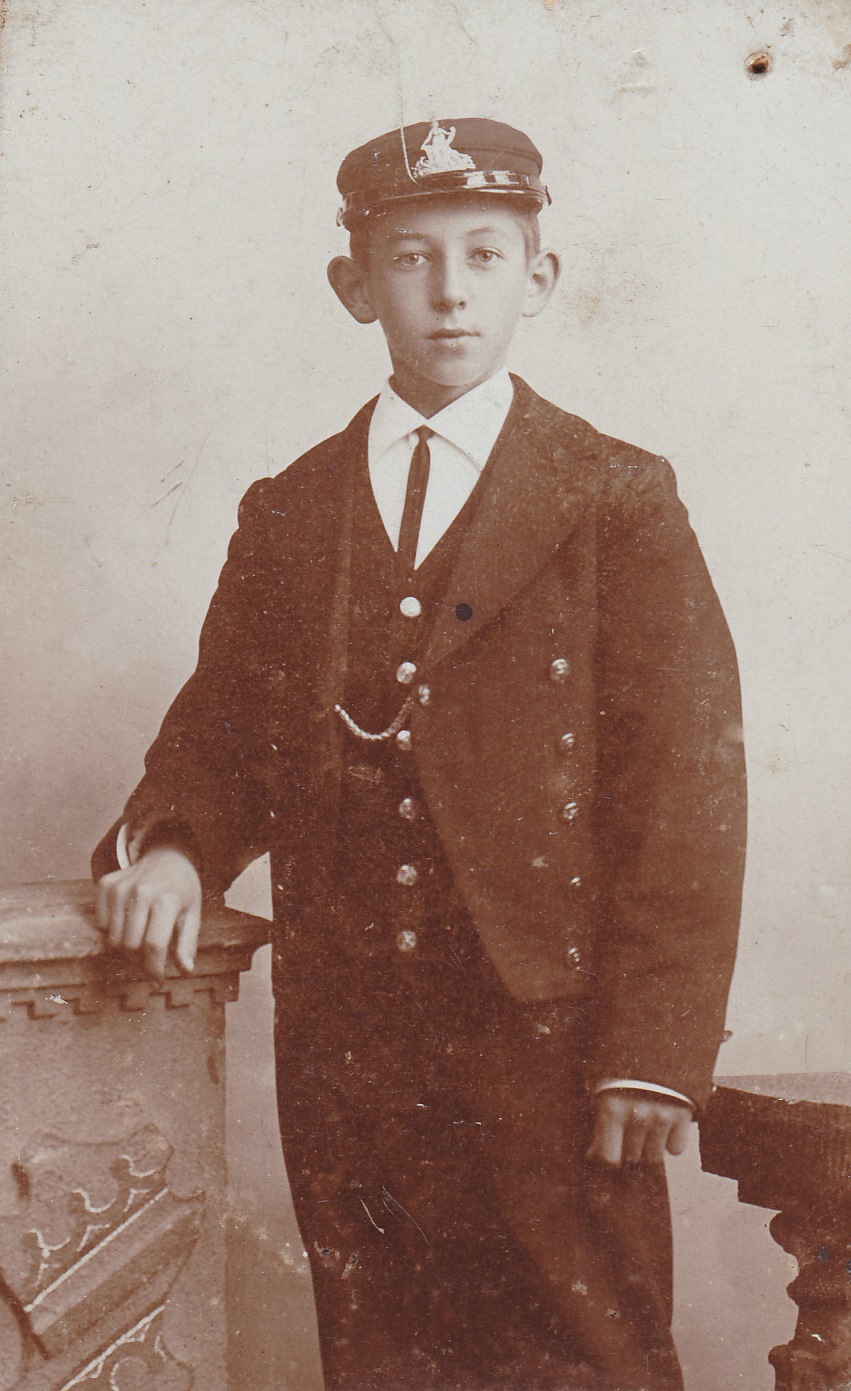
Jan Abraham Hazewinkel as pupil of the Kweekschool voor de Zeevaart 1900 – 1903 (a)
Jan also decided to go the sea and was accepted on 20 August 1900 by the Kweekschool voor de Zeevaart in Amsterdam. He followed the three year course and was then taken on as a cadet by the Holland America Line. He joined the ss Noordam as cadet on 04 Aug. 1903 and remained with the ship until January 1904 when he was transferred to the cargo ship Amsteldijk (I).
The Amsteldijk (I) made 2 month long voyages between Rotterdam and Newport News calling on the return voyage at London (Graves end) and Amsterdam. Unusual for Holland America was that this ship was involved between 1903 and 1905 in carrying cattle from Newport News to England. Having as much as 650 head of cattle on board with about 20 handlers. Carrying livestock has always been a smelly affair but in this case the ship might have been lucky that the on the voyage to Europe the wind was mostly with the ship; and as long as the cattle was housed before the bridge it might not have been so bad.
On 09 November 1904 he passes his exam for 3rd mate and is on 18 November dismissed from the Academy with a very good attest for skills, a very good recommendation from the ship and with good behaviour. He then returns 3 days later to Holland America and placed on the board the ss Noordam as 4th. Officer. Somewhere around this time he moves to Rotterdam where most of the company officers lived, so they did not lose too much time on travelling during their short leaves in between voyages.
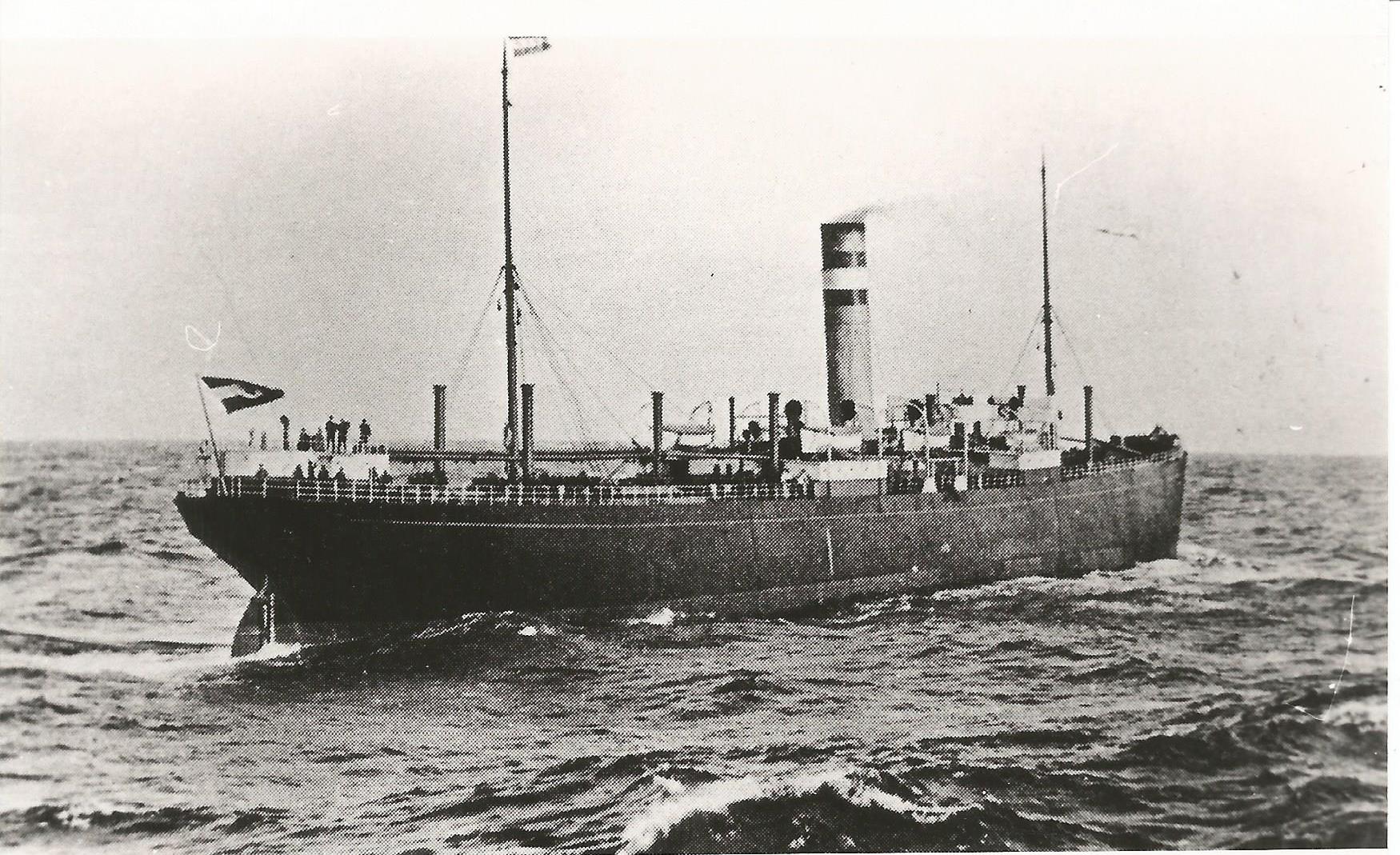
The ss Amsteldijk (I) this ship was one of the first cargo only ships of the Holland America Line, as it joined the fleet in 1901. An interesting detail is the flag at the stern. Just visible is an oval in the middle white band. This is an anchor which indicates that the captain was a Royal Navy Reserve Officer.
In 1905 he enlists as a Special Ensign in the Royal Navy Reserve. Holland America encouraged joining the RNR (or KMR in Dutch) as it would help carrying the Royal Mails on the passenger ships and keeping control of those ships in times of war. Company records indicate that he was still a reserve officer in 1917, when he left the company. It is not known if he kept or was able to keep his connection with the Royal Navy after he went shore side.
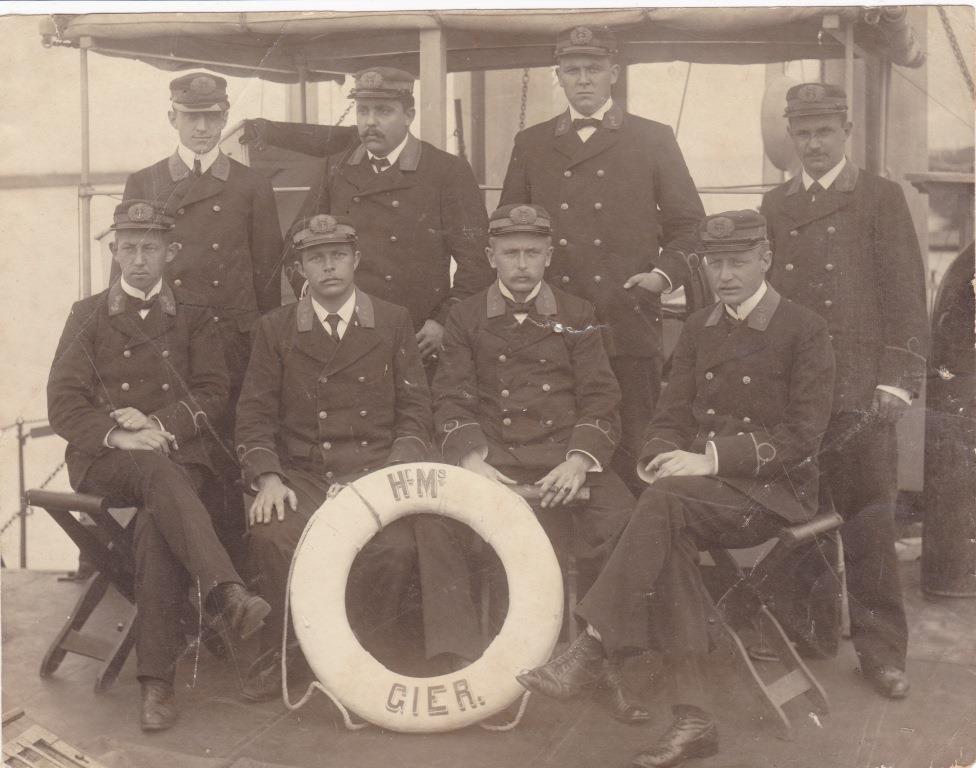
A very scarce photo as there is very little documentation about the Dutch RNR officers of the early days. Here we see a group of Merchant Navy Officers who joined the Navy for their Reserve training as Extraordinary Ensign in 1905 on the Training Ship HMS Gier. This was a gunboat which had been assigned for this work between 1894 to 1907. On the photo from left to right: Standing: A..D Lucas, A. Verschura, A .Noordraven . J Vollewein Sitting: J.A Hazewinkel, van Couten Piccardt, Wieringa, Edgmond, Stapel (a)
This link to the Royal Navy was in his favour as the company did encouraged it and as a result he spent a considerable amount of his sailing time on board the Passenger ships. Here the on board discipline might had been stronger than on the cargo ships but on the other hand you were home every month for a few days and also the food was better. Although the officers had their own mess room, there are many stories out there that extra “provisions” from the passenger kitchens made it up to the mess rooms. He does follow the company doctrine of being assigned to a cargo ship, each time he was promoted to a new rank, but then very quickly he was re-assigned to the passenger ships.
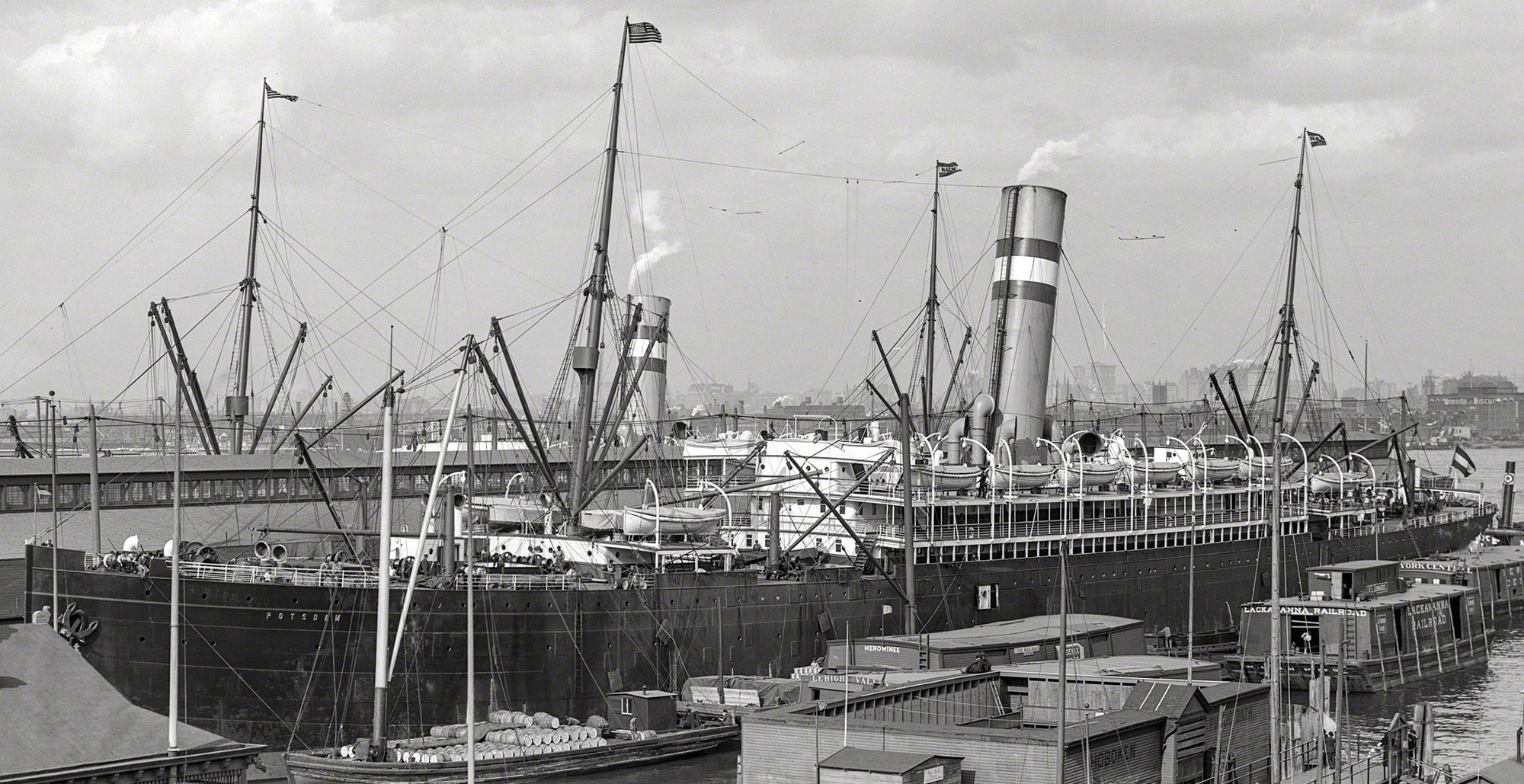
The ss Potsdam. This was one of the passenger ships Hazewinkel sailed on until he received his own command. This ship commissioned in 1900 had the distinction that is was the only “German ” Dam name ever used in the fleet. She is see here at the HAL terminal in Hoboken New York. (f)
With the onset of the First world War, the Kingdom of the Netherlands was neutral but still had to go full mobilization as for some time it was not clear if the German Imperial Forces were planning to March through the Netherlands for a short cut to France by following the coast in order to circumvent the defenses of the Belgians and the French. From September 1913 to early 1914 he is thus assigned again to the Royal Navy whose ships were used in patrols along the Dutch coast to keep an eye on any German movement. Just before being called up he marries on 12 June 1913 in Rotterdam Antonia de Haaij (born 27 Nov. 1892 as daughter of Aart de Haaij and Adriana Lauwaart).
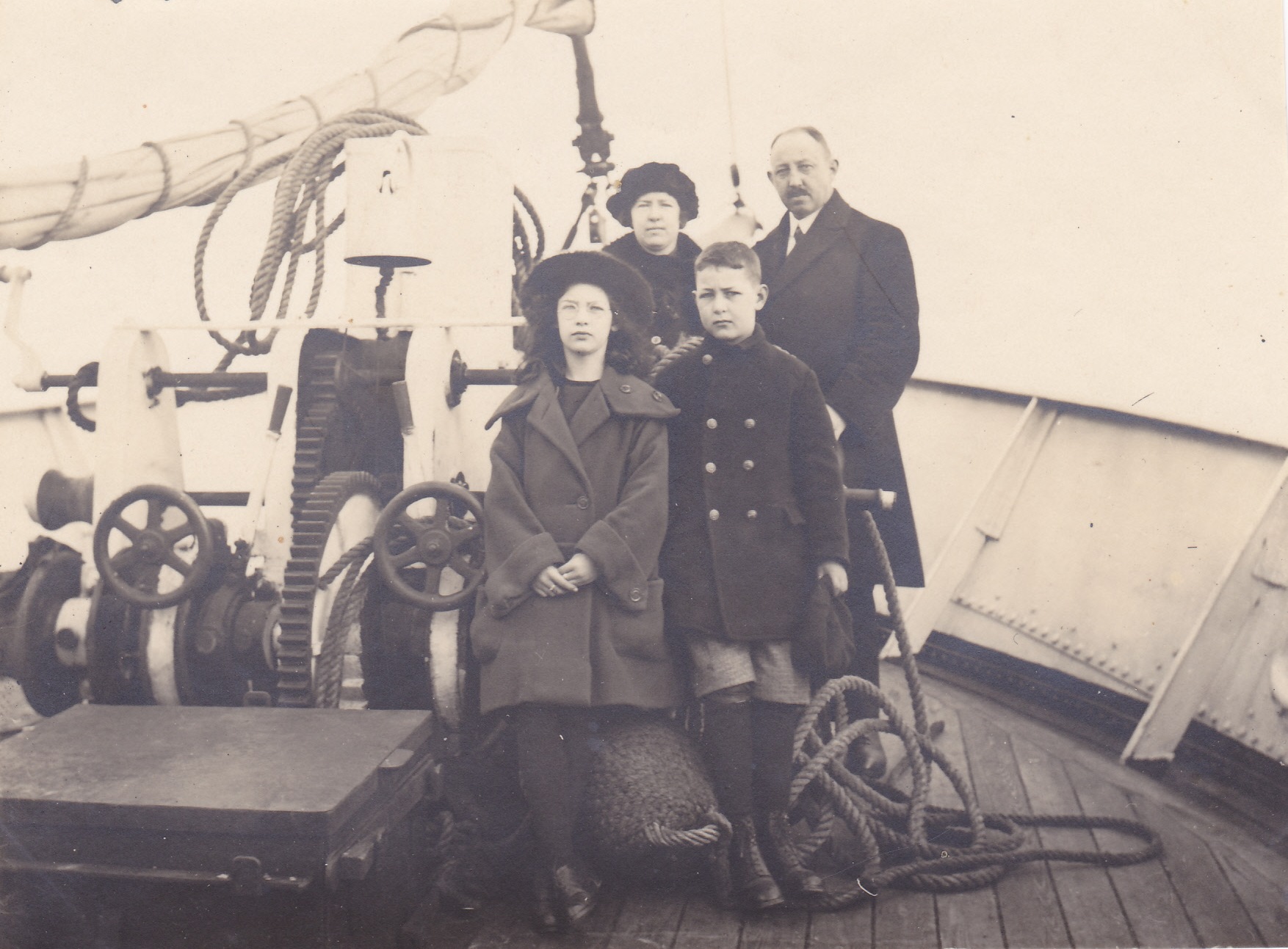
The family Hazewinkel. This photo was taken in 1925 on the bow of the Hospital & Floating church ship ” De Hoop” when she visited Texel and our captain was employed as the Principal of the local Maritime School. (a)
Eventually there were two children Adriana (born 10 Sep. 1914 in Rotterdam and Simon Jan Abraham, born 04 December 1916 also born in Rotterdam. (g)
The German forces decided not to march via the Netherlands and thus he is dismissed a few months later. Here there are dates missing in his voyage listings as held in the company archives but there are family photos that indicate that the was assigned again to the ss Rotterdam, the flag ship of the company by early January as on the 17th. of January 1914 the ship leaves from Rotterdam to New York to commence from there a 50+ day cruise to the Holy Land.
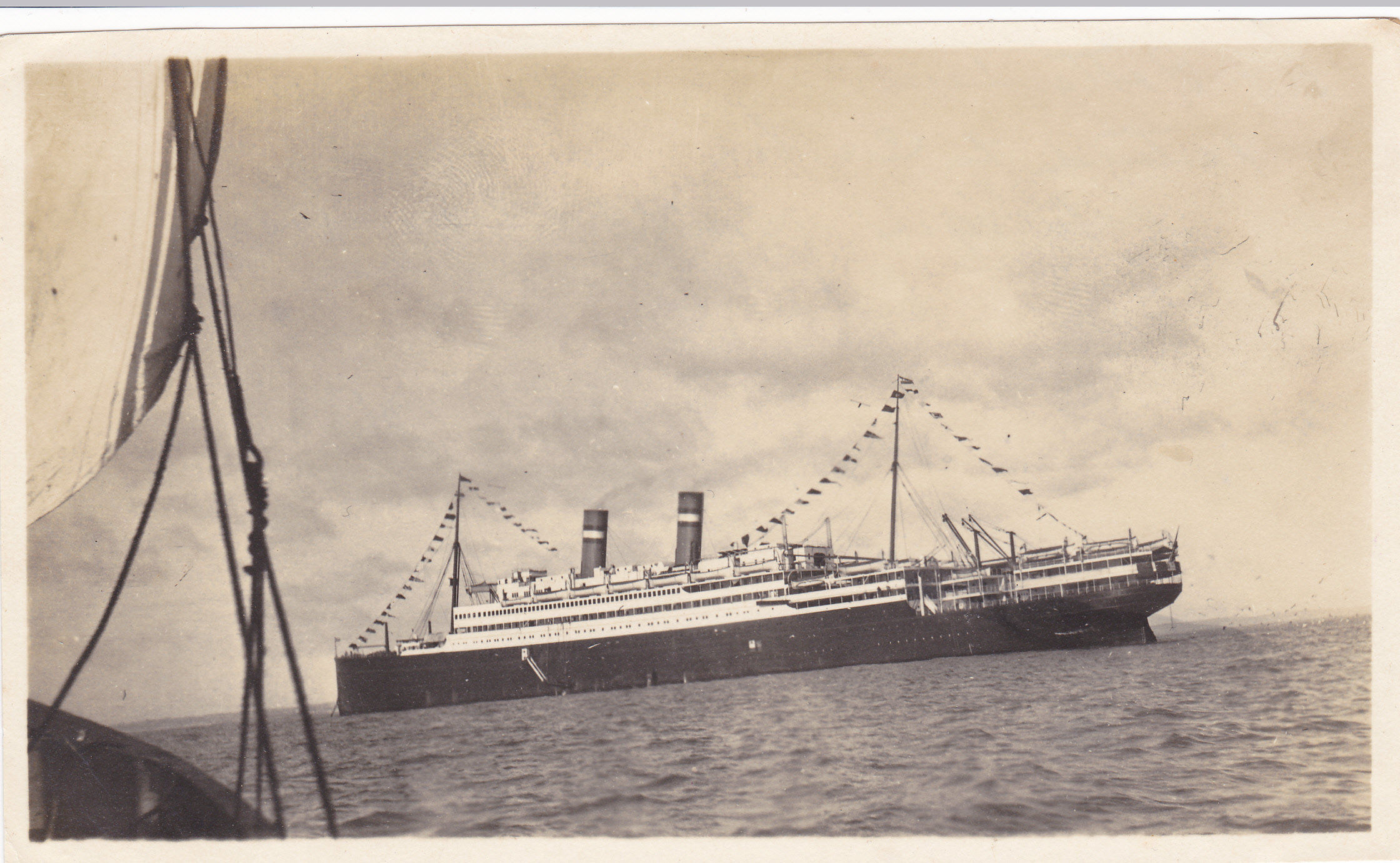
The ss Rotterdam (IV) on her Spring 1914 cruise to the Mediterranean and the Holy Land.. Seen here leaving Cadiz. (a)
His last voyage (14 August – 02 Sep) before becoming captain was also on the Flagship the ss Rotterdam for one voyage. Voyage nbr. 55 with again in command Captain Geert Stenger the company’s Commodore. This ship was now back on a direct service between Rotterdam and New York as the call at Boulogne Sur Mer had been discontinued in August 1914 due to the war situation. On the way back the ship had to call at “The Downs”, the area south of the estuary of the Thames for contraband inspection. Something all neutral ships had to go through. Passenger ships normally got preference and only had 1 or 2 days of delay but cargo ships could be stuck here for a considerable time. While on this voyage he has some excitement as the aft hold section of the ship goes on fire threatening the bags of mail stored there but the ship’s crew can extinguish it rapidly with fire hoses.
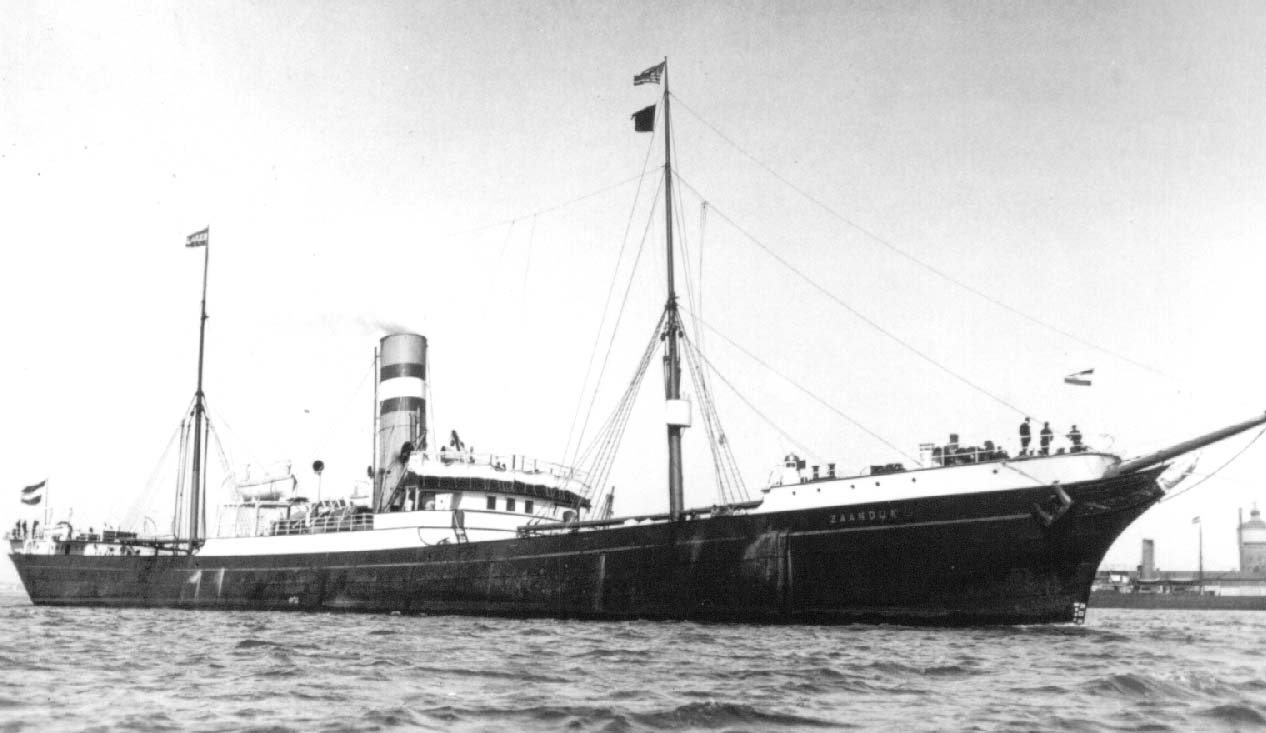
The ss Zaandijk (I) Here you can see that the early cargos hips where basically sailing ships with an steam engine plonked in the middle of the ship. she still has a bow sprit and and figure head as was common for the sailing ships. (f)
Then on 06 December 1915 he is promoted to Captain and assigned to the ss Zaandijk (I) which departs under his command on 10 December for a voyage to New York and back. The war is now in full swing and the ships are constantly exposed to the U-boat threat; and when leaving and returning from Rotterdam subject to contraband inspections by the British and sometimes also by the French. By mid-1916 the submarine threat is so severe that the ships are not any longer going the direct route through the English Channel but via the Orkneys and south of Iceland toward the USA, as in that are the British Royal Navy had a large presence and thus offered a certain amount of protection. Not only from torpedoes but also from mines, laid by the German submarines in the densest shipping lanes.
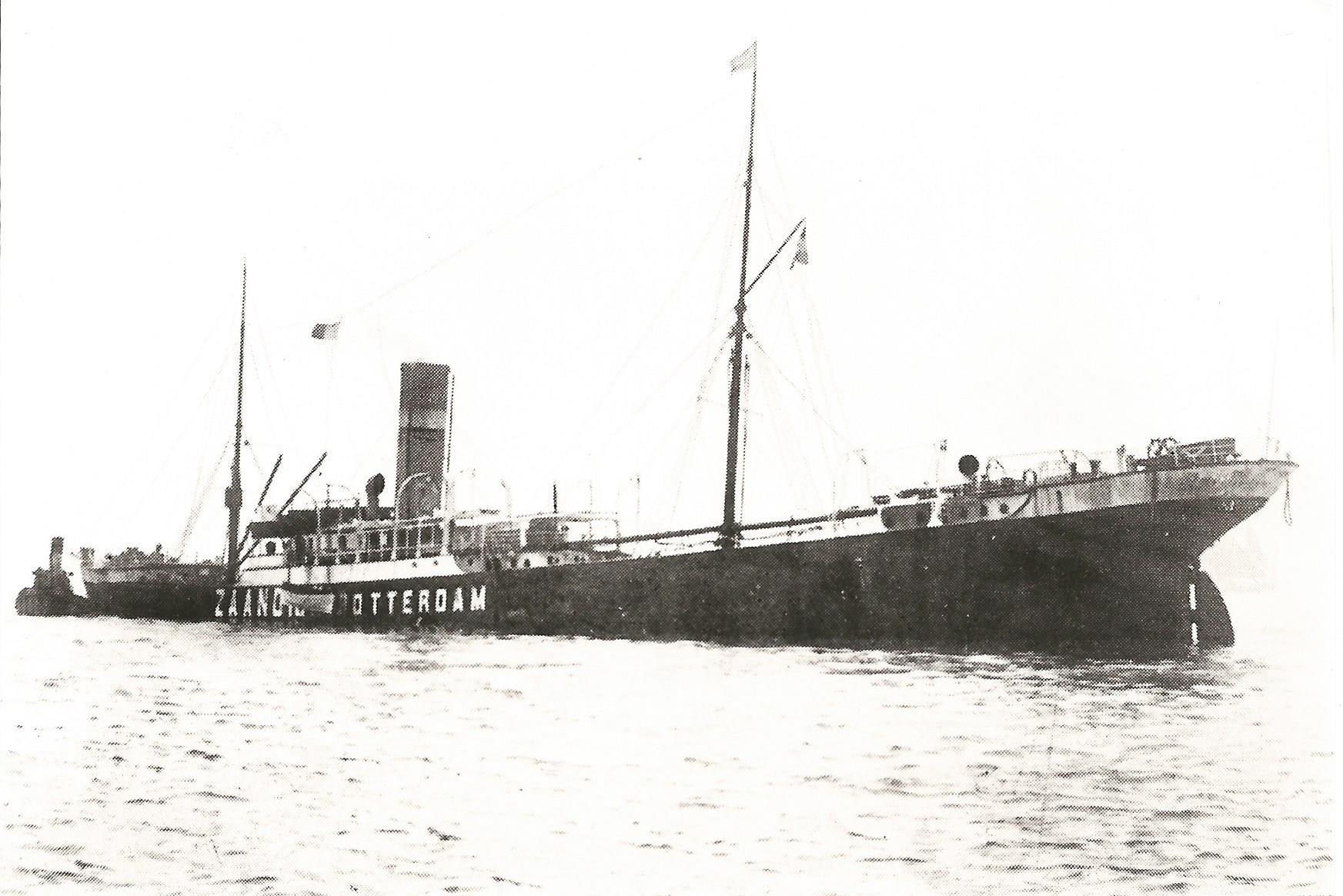
The ss Zaandijk (I) shortly after having hit a mine. Note the neutral letters on the side, meant to advise Submarine commanders not to shoot at neutral ships. It does not help against floating mines.
For the Zaandijk the deviation to North of Great Britain came too late. On 23 January 1916 the ship had left Rotterdam and stopped at the anchorage at Deal from 23 to 25 January for the regular contraband inspection. By now most Holland America Line ships were sailing empty outbound so the inspection did not amount to much, but the ships still had to wait for the Inspector with the Stamp. Then it calls at Halifax and New York, followed by Philadelphia. Most important cargo (at least for the Netherlands) was grain as the country could not produce enough itself and the normal supply from Germany had stopped once the war had started. From Philadelphia the ship sails back to Deal to get clearance from the British for the inbound voyage to Rotterdam.
Then on the departure from the anchorage the ship hits a German mine with the bow. Captain Hazewinkel wrote a chapter about this in a book that was given out after World War I to chronicle the adventures of all the Dutch Merchant ships during that war. (d)

Side view of the ss Zaandijk (I) This drawing is from the Captains narration of 1917. To the right it is says: forward Watertight Collision bulkhead. Installed to protect a ship in case of a head on collision. The mine damage cause this the bottom and this bulkhead to be ripped open, spilling the anchor chains out. (d)
Note by Editor: Looking at this from my own Captains point of view, in situations like this, e.g. getting the chance of being torpedoes or mined, you develop in your mind several scenarios that you might be able to execute. The two most important ones are: will I stay afloat and will I keep propulsion. If you cannot stay afloat then you hope for the option to be able to beach the ship and otherwise go into the lifeboats as soon as possible to save those on board. If you can stay afloat, then the question is for how long, can I move the ship (slowly) or can I get help. The latter preferably without alerting the Enemy.
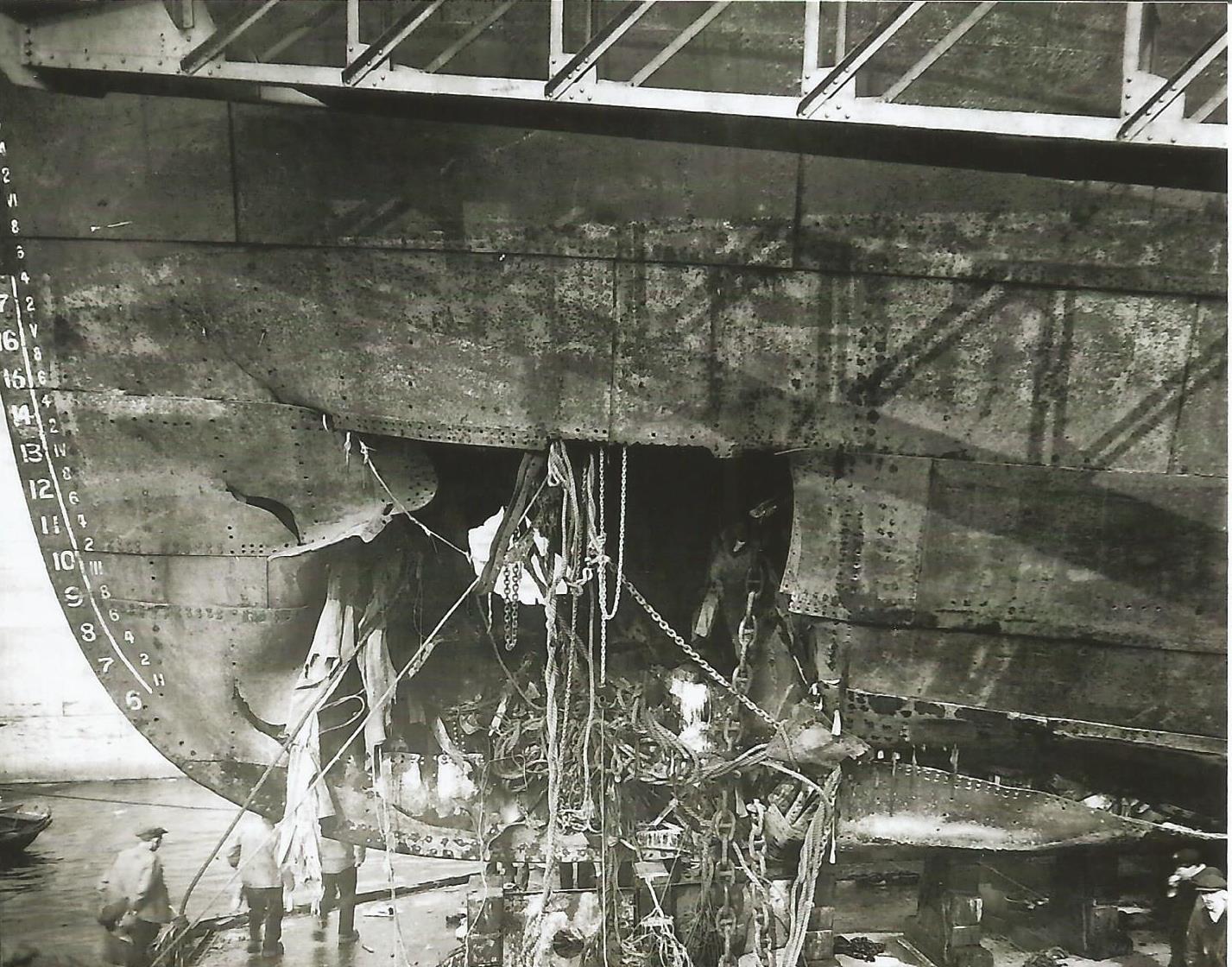
The damage to the bow when the ship arrived in dry dock. (d)
With the Zaandijk and Captain Hazewinkel the following happened. On 11 March 1916 the ship had finished its inspection at Deal (arrival 06 March) with on board a cargo of wheat and general merchandise and by 10, am the ship was on its way to Amsterdam before going to the home port of Rotterdam. Instructions had been received of which channels to follow which had been swept for mines. Just before noon time a heavy explosion occurred at the bow. The ship was stopped and the first thoughts were with the off-duty sailors who were sleeping in the bow. Most of them had been thrown out of their bunks and some were (slightly injured) or dazed. Those were carried to the lifeboats in case the ship would not be able to stay afloat. Hold nbr. I was flooded and the captain was afraid that the watertight bulkhead to Hatch nbr. II (and then the not watertight Hatch nbr. III) would give away as wheat swells and thus expands, when getting wet. With the bow deeply submerged the propeller in the stern was too high out of the water to make steering possible and the Zaandijk just turned around in a circle with the deep laying bow as a sort of involuntary pivot point when this was tried. Also nobody had any idea if the ship would stay afloat due to the pressure of the expanding wheat on the bulkheads. Thus the order abandon ship was given, and the lifeboats tried to stay as close to the ship was possible and observe the situation.
There was no storm, but wind, swell and current made it impossible to keep position near the ship and when the ship did not move at all the Captain decided to reboard. By that time the boats had floated a considerable distance away from the ship and had to take a tow from a passing ship to get back to the Zaandijk. Hatches II and III were still dry and thus the plan is formed to use a passing cargo ships the Colchester of the Harwich – Rotterdam service to tow the Zaandijk to London. This was tried but the towing line is not strong enough and breaks. The Colchester then continues its voyage. But it has Radio Equipment on board and signals London about what is going on. A British Minesweeper shows up and asks that the Zaandijk puts out its anchors as no help will come until the next day. Luckily the North Sea in this area is very shallow (about 90 feet) and thus anchoring is not an issue.
The next morning three tugboats show up. And whatever they try, the ship does not move. An inspection is carried out and it becomes apparent that the explosion had caused the bottom of the bow to fall out and thus both anchor chains had fallen through and onto the sea bottom.
(ED: It is not always understood, but when a ship anchors, the only thing the anchor does, is to keep the chain in place. The ship stays in place by the friction of the anchor chain on the sea bottom. Hence the worse the weather, the more chain a ship will use, to increase the friction and thus the holding strength to keep the ship in position)
Hence the reason that the ss Colchester broke their towing line. Those lines are not as strong as an anchor chain, let alone two of them. It was estimated that about 600 feet of chain was lying on the sea bottom, enough to keep the Zaandijk in position during a good seized storm. When they had anchored the night before, they had used the anchor winch to pay the anchor chain out and had thus done this by heaving up some of this chain from the sea bottom, pulling it through the hawse pipe and then lowering again on the other side. Because of the fact that this worked, they now could heave up all this anchor chain and deposited free from ship. A buoy was attached so the two chains could be retrieved late.
The ship was towed up the Thames to a sand bank which was under water at high tide and completely dry at low tide; an excellent location for temporary repairs. The hatches were strengthened for the additional pressure when the ship would push the bow through the waves and then the Zaandijk could sail under own power to Rotterdam escorted by a Dutch tugboat. 15 days after the occurrence the ship arrived in Rotterdam and removing the cargo commenced. From there it went to dry dock where the full extent of the damage became apparent. On 20 May the ship departed for her next voyage,
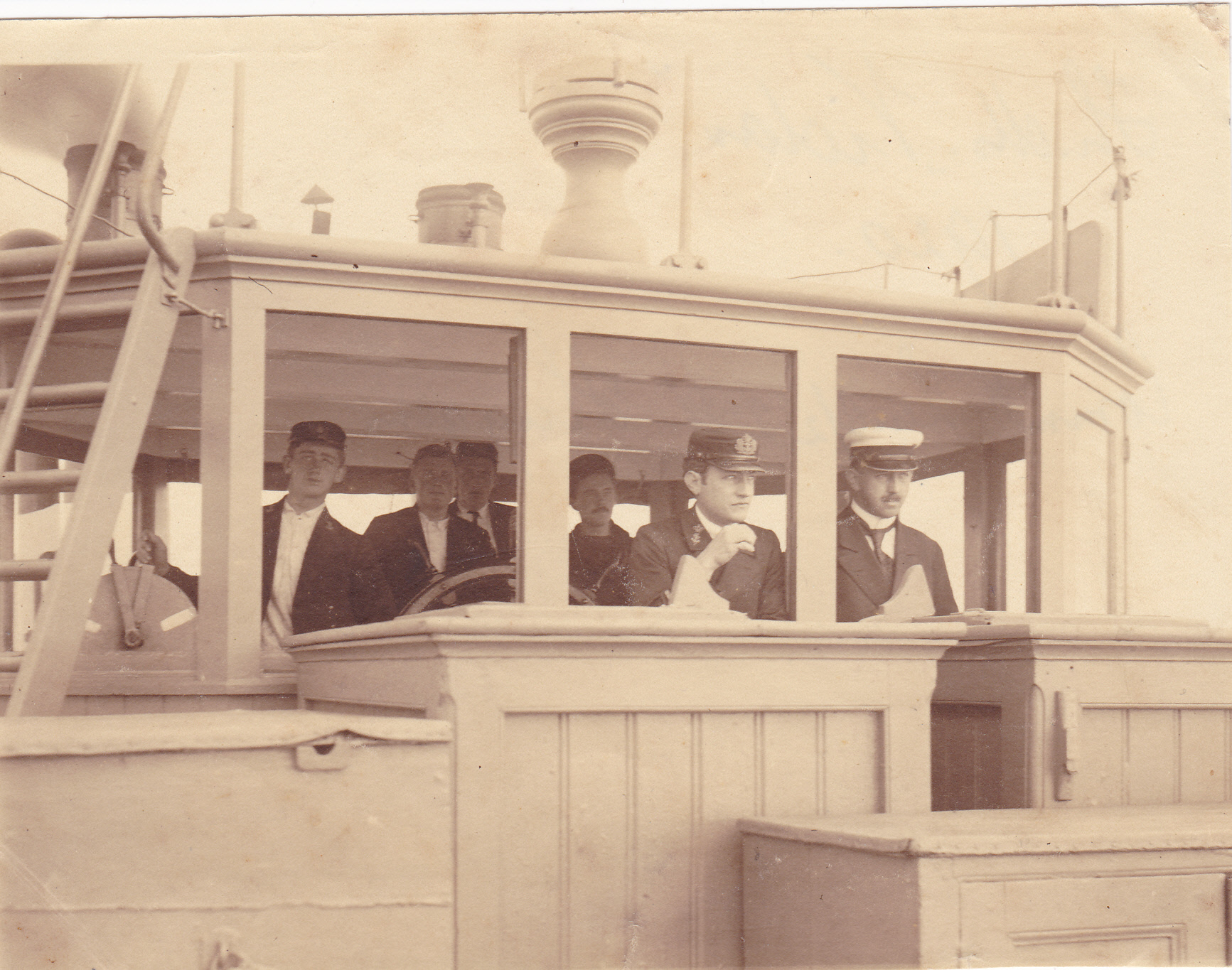
A 1923 photo of School Teacher, now ex. Capt. Hazewinkel (to the right with white cap) and some pupils on board HMS (Hr.Ms in Dutch) Vidar during a training trip on the Zuiderzee. The man with the black cap is the commanding officer Lt. 2nd class Huygens. (a)
Captain Hazewinkel remained with the Zaandijk until 23 January 1917 and is then called away for another spell with the Dutch Royal Navy. While here he decides to quit the sea and to become a teacher. Thus in September 1917 He returns to his old school in Amsterdam as a Lecturer for Mathematics and Navigation. It does not last long as in 1923 he is put on standby money as the school had to reduce the costs as there were less students that could be taken in as there was no place to go for them on the Dutch merchant fleet.
In 1924 he was appointed as the Principal of the Maritime College on the Island of Texel. Here he also became the chairman of the local committee for the (KNZRM) Royal Dutch Lifesaving Association for North and South of Holland.
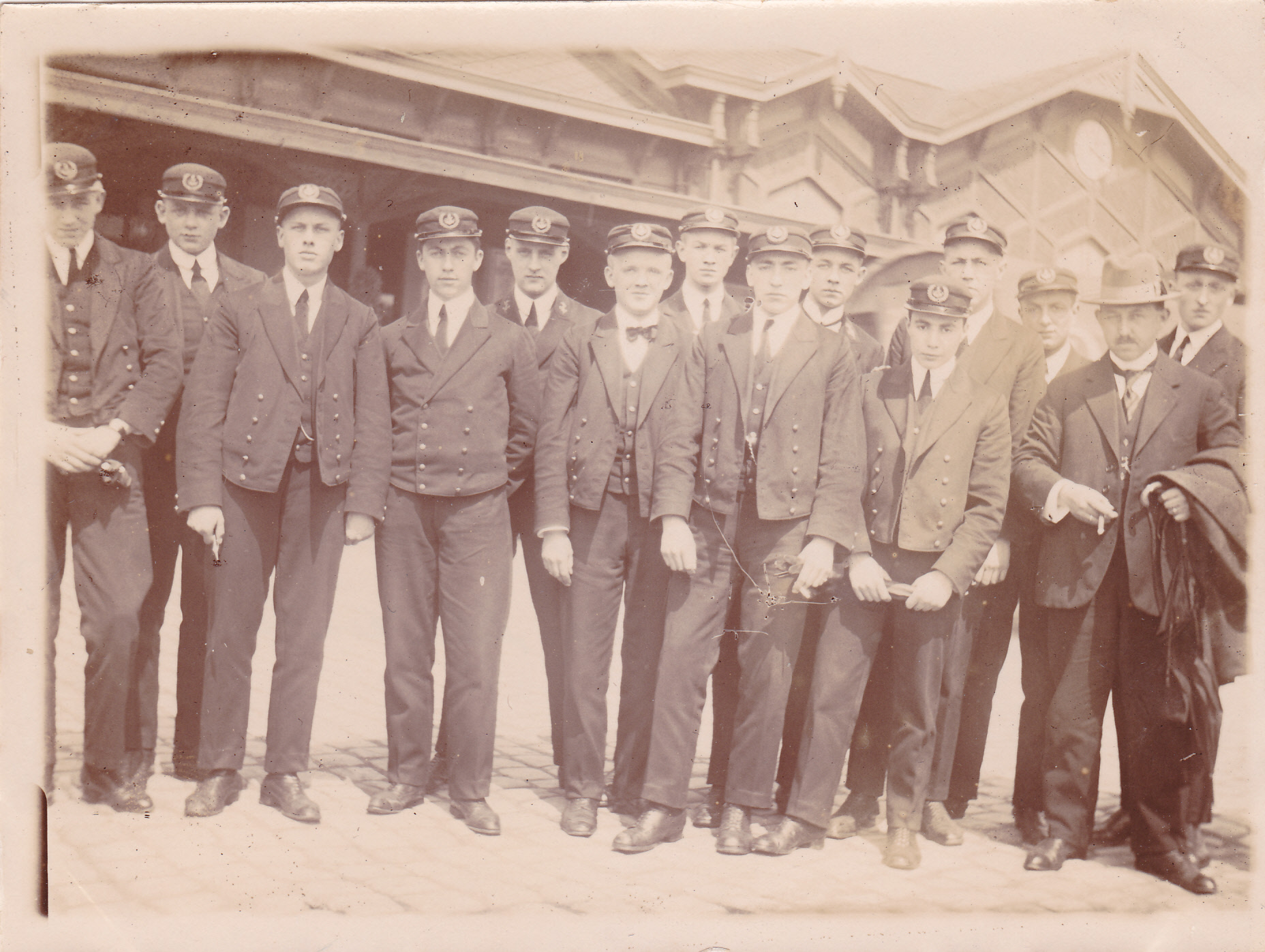
School outing, taking the pupils for a visit to the Maritime Museum in Rotterdam. (which was better of this sort of work than Amsterdam as it also had a modern section with exhibition of new ships and equipment. Captain Hazewinkel is seen to the right. The pupils from left to right: Schuyling, Verkruysen, Kuijer, Bruining, V/t Hoff, Bartles, v.d Meer, Korver, Huissteden, Senator, Lagaay, De Boer, starkenburg.
In 1927 there is an opening in Amsterdam and he returns to his old position, where he remains until his retirement in 1950. An anecdote from those days regales the unique way in which he would conduct his lecturing. To ensure that all that was in the curriculum was also handed over to the pupils he had the lessons precisely split up over the whole season. To such an extent that if the school bell went, denoting the end of the class hour, he would stop in mid-sentence. When the lesson would continue at another time he would start the lesson in this mid-sentence and just continue.
(ED. I am wondering what he would have done he would missed classes due to illness? Call everybody back to catch up? That would have been really appreciated by the Academy as the Board was really fanatical about keeping their Academy the best in the Netherlands.
So far there is very little known about his life after returning to Amsterdam in 1927. But it seems he passed away in 1963. Family historians agree that he was the last Captain – seafarer of the Family.
Sources:
With a special thank you to Mr. Ed Vermeulen who provide a large number of photos of which I have selected a few to include in this biography.
- a. Familie Archief Hazewinkel via Mr. Ed Vermeulen.
- b. Voortvaren naar Zee Kroniek van de Kapiteins Hazewinkel by Eiloc van Koldam Published 1997.
- c. Scheepsindex.nl
- d. De Nederlandsche Koopvaardij in den Wereldoorlog. J Hoogendijk
- e. Stamboek and Movement books of the Holland Amerika Liin Archives, as held by the Municipal Archives of the city of Rotterdam
- f. Albert Schoonderbeek Archive.
- g. E.A Kruidhof
Sailing List: (e )
Date: Function: Ship: Wages and/or remarks.
05 Aug. 1903 Cadet Noordam 10,–
02 Jan. 1904 Cadet Amsteldijk 10,–
01 Mar. 1904 Cadet Amsteldijk 10,–
17 Aug. 1904 Temporary dismissed for 3rd Officer’s exam.
09 nov.1904 Passed exam for 3rd Officer
21 Nov. 1904 4th. Officer Noordam 30,–
01 Jan. 1905 Commissioned as Special Ensign in the Dutch Royal Navy Reserve. (KNMR)
17 Feb. 1905 4th.Oofficer Rotterdam 30,–
22 May 1905 temporary dismissed due to service with KNMR
29 Jun. 1905 4th. Officer Rijndam 30,–
22 Nov. 1905 4th. Officer Sloterdijk 30,–
27 Feb. 1906 4th. Officer Potsdam 30,–
02 Jun. 1906 Temporary dismissed due to very supervision of the daily work.
02 Jul. 1906 3rd. Officer Sloterdijk 40,–
21 Nov. 1906. 3rd Officer Rijndam 40,–
07 Feb. 1907 3rd Officer Noordam 40,–
19 Apr. 1907 Temporary dismissed due to obtaining 2nd rank. Passed.
15 Jul. 1907 3rd. officer Potsdam 50,–
28 Sep. 1907 Temporary dismissed
14 Oct. 1907 3rd Officer Sloterdijk 50,–
11 Dec. 1907 3rd. Officer Amsteldijk 50,–
12 Mar. 1908 3rd Officer Rijndam 50,–
28 Apr. 1908 2nd Officer Amsteldijk 60,–
12 Feb. 1909 2nd Officer Sloterdijk 60,–
25 Mar. 1909 2nd Officer Noordam 70,–
30 Apr. 1910 Temporary dismissed for study first rank. Passed 14 Sep. 1910.
01 Oct. 1910 For a training of six months placed with the Royal Navy.
Starting on 1 January 1911, due to a review of the wages, the month income is set at 130,–
03 Apr. 1911 2nd Officer Rijndam 130,–
03 Nov. 1911 Act. Chief Officer Zijldijk 140,–
29 Jan. 1913 Chief Officer Zijldijk 140,–
02 Mar. 1913 Temporary ashore awaiting placement as Chief Officer on board Sloterdijk.
14 Mar. 1913 Placement cancelled.
14 Mar. 1913 Chief Officer Nieuw Amsterdam 140,–
18 Apr. 1913 Wages increased to 160,–
18 Apr. 1913 Chief Officer Amsteldijk 160,–
28 Dec. 1913 Temporary dismissed for Royal Navy service due to the mobilization
04 Aug. 1915 Wages increased 200,–
04 Aug. 1915 Chief Officer Rotterdam 200,-
06 Dec. 1915 Captain Zaandijk 250,–
27 Jan. 1917 Temporary dismissed for Royal Navy service.
01 Jun. 1917 Temporary dismissed from our service.
Wages increased to 300,– if returning eventually,
Updated 20 January 2021

Leave a Reply